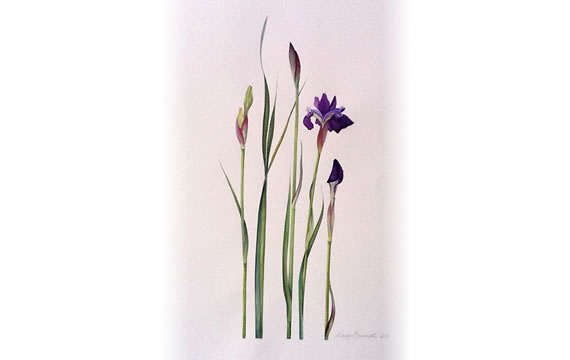with Gillian Condy and Elsa Pooley
The Cavern, Drakensberg Mountains, Natal
21-27 October 2012
By Wendy Burchell
Helen Meyer and I booked very early for our course in the ‘berg and looked forward to it for months. It fulfilled all our expectations and more!
We flew to Lanseria, suitcases groaning with art materials, a few clothes for the week and our precious Arches hot pressed paper in an unwieldy, wide canvas bag to keep it pristine. Jackie Hugo, Helen’s sister-in-law and active member of BAASA Gauteng, fetched us from the airport and the following morning, drove us to ‘The Cavern’. I had forgotten how soft, green and beautiful the Drakensberg mountains are.
On arrival at the hotel we were greeted by the sight of our teachers ferrying armfuls of art equipment, books, lamps and boxes of glass jars down to the large, light-filled studio that was to be our base for seven days. We chose tables, put down art bags and joined the rest of the group for an al fresco lunch on the patio upstairs. Five students – Helen Meyer, Jackie Hugo, Elaine Lucey, Patricia Whitbread and myself – and two teachers – promised an exclusive ‘one on one’ tuition week in botanical watercolour painting.

Classes started immediately after lunch with Elsa and Gill introducing themselves. We knew Elsa as ‘the tree specialist’ but didn’t know that she is first an artist, having been encouraged to paint the flora in her home surroundings at Ndumu Game Reserve by her late husband Tony, well known game warden and crocodile specialist. I was interested to learn that she illustrated the trees, wild flowers, ferns, sedges and restios sections in Vincent Carruther’s book “The Wildlife of South Africa” which I have consulted for years, as reference for my botanical needlepoint designs. Gill has led a fascinating, peripatetic life, painting and documenting the plants in England, Botswana, Mozambique and South Africa.
Outside the studio was a long table laden with glass jars filled with freshly collected plant material. Flowers were selected from the many specimens: crinum lilies (Helen and I), agapanthus (Elaine), arums (Jackie), wild pomegranate (Pat), scilla (Gill), anemone (Elsa) and irises . After two hours of drawing large lily buds, I realised I would never complete these in a week, so left that daunting task to Helen and chose dark purple irises which, of course, are not indigenous! My uncanny knack of choosing the exotic!
We started with preliminary sketches using sharp HB or 2B pencils, drawing different angles to get the best view of the plant. Accurate measurements, tonal studies and notes on special characteristics of the plant followed. This took three full days! Only once Gill or Elsa had ‘passed the drawings‘ could we proceed to the lightboxes in the darkroom at the side of the studio. Simple, clean, line drawings traced onto 90g tracing paper were used to transfer the plant drawings onto Arches HP paper.
We learned a fundamental lesson – once the teacher’s approval has been given, do not change the drawing, even if the plant has changed, which it inevitably will, despite your efforts! Because it is living, buds open, flowers fade and leaves turn – hence the necessity for copious descriptive notes, good tonal studies and accurate paint colour samples accompanying initial drawings. We discovered the importance of sharp pencils which make a huge difference to plant accuracy. In fact, all rules and stages of botanical watercolour painting are vital – you cannot omit some and jump ahead as there will be noticeable, disappointing consequences.
Botanical illustration will not be hurried!
We took frequent breaks to rest our eyes, shoulders and lungs (yes one forgets to breathe with all that concentration) and The Cavern staff provided a range of teas, percolated coffee and delicious home-baked biscuits/cakes throughout the day. Self discipline was also needed here!
Day four involved paint matching, mixing and making colour charts and only then could we start our paintings. It was fascinating to watch the different styles emerging. Each problem was patiently resolved by our generous teachers with knowledge accumulated over years of practice and their experience of familiar frustrations. At night, Gill and Elsa would retire to the studio to work quietly on their own masterpieces – “gobsmackingly” beautiful and inspirational. Oh to acquire such painting ability!
Every morning at 5:30 and afternoon at 4:30, weather permitting, Elsa led walks into the surrounding mountains, pointing out the flora and ecosystems of each area. What a treat it was to walk with this tall, gentle soul and share her extraordinary knowledge of nature. She and Gilly were always armed with plastic bags and sharp secateurs in case they spotted: ‘a juicy plant specimen just asking to be painted’. The October weather was perfect with warm days and intermittent, cooling showers. Luckily the hotel shop offered raincoats, walking sticks, takkies and other requirements for hotel guests who forgot theirs!
After showering and changing for dinner, we’d grab a drink at the cosy pub and head for the TV room to watch a series of Gill’s videos on watercolour painting. Candlelit, gourmet dinners were served by friendly, professional waiters who listened patiently to the very specific orders from our group with their various food allergies. The dining room and other hotel walls are adorned with original botanical artworks by Gill and past course members – so inspiring!
On the last morning our paintings were put up in the studio for critical assessment. Gill and Elsa offered constructive comments and in turn, we commented on what we had derived from the course. Each artist had improved noticeably.
The hotel owners, who show a keen interest in these courses, came to see our artwork and to hand out Gillian Condy certificates of attendance.
They share a special relationship with Elsa and Gill which ensures a wonderful art experience at The Cavern in the Drakensberg Mountains.
